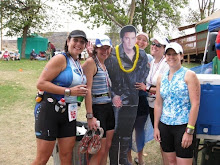[Highlights taken from an article that appeared in Active.com]
There are interesting new tools designed to aid the bike fitting process.
Some incorporate dynamic motion sensing and capture technology. As a gadget guy, I am compelled by new technology, and I often get asked what the "best" fit system or process is. Unfortunately this question circumvents the most key component of a good bicycle fit—how skilled or experienced the person performing the fit may be.
Advanced technology does not necessarily make for a better or more accurate fit any more than a heart rate monitor or power meter automates a better athlete. What is more important beyond the respective joint angles is that there is a feedback loop between the athlete and the fitter.
What Computers Won't Tell You
I find that too much technological integration can impede this at times or become a distraction.
There is a point of diminishing returns when it comes to fit technology or technology in general. The athlete can be overwhelmed with information that has little relevance to how the bike fit actually feels or performs off the fit platform. For the fit technician, over-reliance on a computerized process may keep the inexperienced fitter from seeing the forest for the trees.
The Key to the Best Bike Fit
It is more important to search for an experienced and trained fitter than it is to find the most advanced fit system. Fitting takes years of experience, but a computer program can be purchased by any shop or person. More importantly the fitter must properly evaluate and communicate adjustments to the athlete.
Fitting should be a dynamic and interactive process, and not rushed. The best fit that hits the proper joint angles precisely is still only a good starting point and will require the athlete to acclimate to or even require small adjustments post-fit.
I recommend the following criteria when choosing a fit professional and spending your dollars wisely:
- Check references, reputation, and experience. You may be paying top dollar for a fitter with very little experience.
- Look for a technician trained and certified by a body such as the Serrotta International Cycling Institute.
- Don't buy more than you need. A good fitting should be performed on a $500 or $5,000 bicycle. If your objective is simply to be fitted for the "Big 3" of comfort, power, and aerodynamics and you are not experiencing any pain or "hot spots," you may not need the most advanced biomechanical analysis.
As a fit become more problematic (leg-length discrepancy, injury or muscle imbalance) these tools become much more relevant to the fit process, yet they are often used as marketing tools to up sell all fits. - Try to address equipment change in advance if possible. If you are considering a new saddle or aerobars, it may significantly change your fit. Your fitter should consult with you on equipment selection, and it is better to make these changes prior to your fit.
- Ask questions and give information. Your fit technician should evaluate you and the type of cycling you are pursuing. If your goal is comfort for a century ride vs. competitive road racing, this should be factored into the fit along with your injury history, flexibility and biomechanics. They should take time to observe you on the bike and in motion before making any adjustments.
Fitting is a process that requires acclimation. This may take some time, but if your position is painful or uncomfortable, it is not the right one. This not only affects performance, but also your motivation and enjoyment of cycling in general.
No one should have to ride in pain when it can be prevented or addressed.
Matt Russ has coached and trained athletes up to the professional level, domestically and internationally, for over 15 years. He currently holds the highest level of licensing by both USA Triathlon and USA Cycling, and is a licensed USA Track and Field Coach. Matt is Head Coach and owner of The Sport Factory, and coaches athletes of all levels full time. He is also a freelance author and his articles are regularly featured in a variety of magazines and websites. Visit www.thesportfactory.com for more information or email him at coachmatt@thesportfactory.com





















No comments:
Post a Comment